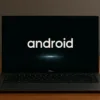Imagine a world without laptops, tablets, or even desktop computers. Everything you need is always in your pocket – and I mean your phone, not your wallet. In this context, Google has just confirmed a long-standing rumor: Android and ChromeOS will become one. The merger of Android and ChromeOS heralds just that
“We combine ChromeOS and Android into a single platform,” Sameer Samat, Google’s head of the Android ecosystem, confirmed in an interview with TechRadar. It’s a change that has been rumored in tech circles for a decade. But this time, it’s finally not just smoke, but fire. So let’s take a look – the unification of Android and ChromeOS.
Why is Google so in love with the idea of one system?
Google has experimented with bringing its two operating systems closer together in recent years. ChromeOS already runs on a number of laptops that run Android apps, and Android phones this year are getting features we've never associated with mobile devices: desktop mode, flexible windows, and more. It looks like Google is finally picking up the pace and realizing that a single, unified system is simply the more logical step forward.
But why now? Google has apparently started to notice in recent years that the line between phones, tablets, and laptops is blurring faster than the smudges on a new Pixel screen. The company hopes that the merger will reduce confusion, simplify app development, and allow users to switch between devices without painful compromises. The merger of Android and ChromeOS will be one of the major technological revolutions of this year.
A revolution or just another technical compromise?
For all the euphoria this announcement is causing in the tech world, some very specific questions remain. Will the combined system be stable and scalable enough for demanding ChromeOS users, such as schools and businesses? After all, Google is still chasing Apple's iPad in the world of tablets and laptops, where the robustness and reliability that users expect from Apple still reign supreme.
Google needs to be careful not to repeat the mistakes of the past, when big leaps into the future also brought big headaches. Is this move a real revolution or is it just a compromise that will please some and disappoint others? The merger of Android and ChromeOS is crucial for Google.
Great challenges, but also opportunities, are on the horizon.
Google, known for its quick approach to innovation, will have to tread more carefully with this merger. Older devices could quickly become obsolete if the new system no longer supports them, which could upset a large portion of existing Chromebook and Android tablet users.
But on the other side of this equation lies a huge opportunity: if Google manages to create an operating system that runs smoothly on phones, tablets, and computers, it will truly offer what Apple doesn't (yet) - a completely universal solution that you always carry in your pocket.
The near future or just Google's fantasy?
Although Samat confirmed the merger, the timeline is not yet entirely clear. Experts predict that we could see the first devices with the new system as early as late 2025 or early 2026. But we know Google - where promises fly high, but reality often lands a little lower.
It's time for a smartphone that can do it all
If Google succeeds with this move, the future is clear: your smartphone will become the only device you'll ever need. If it fails, it'll be another story about the technological promises we've been hearing about for years.
So, dear Google: the ball is in your court. Will you finally truly fulfill our mobile dreams, or will you once again leave us waiting for something that always seems just one more major update away?






